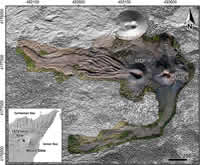UAV-based remote sensing surveys of lava flow fields: a case study from Etna’s 1974 channel-fed lava flows
Favalli M., A. Fornaciai, L. Nannipieri, A. Harris, S. Calvari, C. Lormand (2018).
Bulletin of Volvanology, 80/3, https://doi.org/10.1007/s00445-018-1192-6.
Abstract
During an eruption, time scales of topographic change are fast and involve vertical and planimetric evolution of millimeters to meters as the event progresses. Repeat production of high spatial resolution terrain models of lava flow fields over time scales of a few hours is thus a high-value capability in tracking the buildup of the deposit. Among the wide range of terrestrial and aerial methods available to collect such topographic data, the use of an unmanned aerial vehicle (UAV) as an acquisition platform, together with structure from motion (SfM) photogrammetry, has become especially useful. This approach allows high-frequency production of centimeter-scale terrain models over kilometer-scale areas, including dangerous and inaccessible zones, with low cost and minimal hazard to personnel. This study presents the application of such an integrated UAV-SfM method to generate a high spatial resolution digital terrain model and orthomosaic of Mount Etna’s January–February 1974 lava flow field. The SfM method, applied to images acquired using a UAV platform, enabled the extraction of a very high spatial resolution (20 cm) digital elevation model and the generation of a 3-cm orthomosaic covering an area of 1.35 km2. This spatial resolution enabled us to analyze the morphology of sub-meter-scale features, such as folds, blocks, and cracks, over kilometer-scale areas. The 3-cm orthomosaic allowed us to further push the analysis to centimeter-scale grain size distribution of the lava surface. Using these data, we define three types of crust structure and relate them to positions within a channel-fed ʻaʻā flow system. These crust structures are (i) flow parallel shear lines, (ii) raft zones, and (iii) folded zones. Flow parallel shear lines are found at the channel edges, and are 2-m-wide and 0.25-m-deep zones running along the levee base and in which cracking is intense. They result from intense shearing between the moving channel lava and the static levee lava. In zones where initial levees are just beginning to form, these subtle features are the only marker that delimits the moving lava from the stagnant marginal lava. Rafts generally form as the system changes from a stable to a transitional channel regime. Over this 170-m-long zone, the channel broadens from 8 to 70 m and rafts are characterized by topographically higher and poorly cracked areas, surrounded by lower, heavily cracked areas. We interpret the rafts as forming due to breakup of crust zones, previously moving in a coherent manner in the narrow proximal channel reach. Folded zones involve arcuate, cross-flow ridges with their apexes pointing down-flow, where ridges have relatively small clasts and depressions are of coarser-grained breccia. Our folds have wavelengths of 10 m and amplitudes of 1 m; are found towards the flow front, down-flow of the raft zones; and are associated with piling up of lava behind a static or slowly moving flow front. The very high spatial resolution topographic data available from UAV-SfM allow us to resolve surfaces where roughness has a vertical and horizontal scale of variation that is less than 1 m. This is the case over pāhoehoe and ʻaʻā flow surfaces, and thus allows us to explore those new structures that are only apparent in the sub-metric data. Moreover, during future eruptions, the possibility to acquire such information in near-real time will allow a prompt analysis of developing lava flow fields and structures therein, such as developing lava channel systems, so as to contribute to timely hazard assessment, modeling, and projections.


